
Cauterizing Tools Page Menu: 1 2 3 4 5 6 Next>>
Cauterizing Tools of the Golden Age of Piracy, Page 5
Actual Cautery Properties - Cautery Types
"The 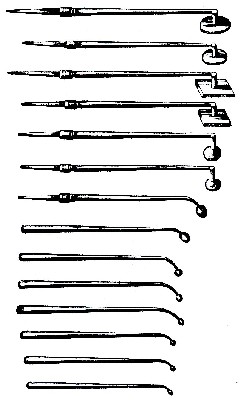
Artist: Jonas Arnold Delineavi
Cautery Iron Styles, from Scultetus's
Armamentarium Chirurgicum Bipartitum (1666)
foresayed cauteryes, & especiallye those, which are made, & composed of any mettle, are also differinge in their figures the one from the other: For everye cauterye must be proportioned, accordinge to the dissease..." (Jacques Guillemeau, The French Chirurgerie, p. 40)
As has been already noted, cautery irons came in a wide variety of types and sizes. If the surgeon needed a different style, he would simply go and have one made that met his needs. Guillemeau lists some different types of cauteries and their functions.
...some are like heades of great nayles, & triangled, others rownde, like unto a butto[n], others cutting, some not dislike unto a halfe moone, and others circlewyse: As we may behoulde, and see, the circles of Albucasis, other in foreme of a rapers [rapier] blade, as Celsus describeth, therwith to cauterize the fissures in the lippes."1
Ambroise Paré provides a list as well, sorting the various cauteries by function. As he details, "som of these work by pricking, som by cutting, som flat-wise, and other-som with their points made to the form of an Olive-leaf."2 While Paré's list is a bit more succinct and logical than Guillemeau's, it is missing the rounded cauteries. With this in mind, we'll examine the cauteries that appear repeatedly in illustrations and manuals from our period authors, dividing them into four types: pricking, cutting, flat, and rounded.
1 Jacques Guillemeau, The French Chirurgerie, p. 40; 2 Ambroise Paré, The Workes of that Famous Chirurgion Ambrose Parey, p. 485
Actual Cautery Properties - Cautery Types: Pointed
Pointed cauteries were made for piercing or pricking or to do fine work when working on wounds. Such a thin, pointed cautery might be ideal for burning away caries - or rotten places in the bones- when the bone was deeply seated in the skin.
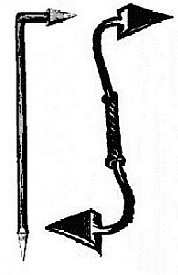
Puncturing Cautery Irons,
Jacques Guillemeau (1597)
& Ambrose Paré (1649)
Jacques Guillemeau provides the most insight into the construction of cautery irons and we will be relying on his descriptions repeatedly in this section. He identifies two different types of pointed irons, which he calls the puncual [probably meant as 'puncturing'] and the emsis.1 Pierre Dionis, whose book appears to have been better translated, refers to the emsel as an 'Ensel'2, so we will call it that as well.
Guillemeau explains that the "puncualle Cautery [seen at left], which is quadtangulede [four-sided], and acute, it is necessarye to open anye Apostumations [swollen, often pus-filled, skin lesions]."3 This function of the cautery iron is not identified by other authors. Why a heated iron was needed for an apostemation is a mystery.
Dionis explains that the ensel [seen below] is called this because "its Point being like that of a Sword."4 Curiously, I could find no support for the word 'ensel' referring to sword in English or French. Nevertheless, Guilleameau agrees with this, explaining that this cautery "hath a poyncte [point] like unto a Rapier... which is partlye on both sides rescindente [tapered back]."5
Guillemeau also tells the reader that "the handle, which is smaller then it is needful... must be foure, or five inches long: and, in like sorte also all the other handles of the other Cauteryes, which are here notede unto you."6 This brings up an intersting point about the drawings we are using here - many of them do not appear to be to scale. Several of the cauteries do not even have a handle, such as Scultetus' image (fourth from the right, below). This is because some surgeons would have interchangeable wood handles that would be shared amongst their irons. So our focus in this section should be on the head, rather than the handles.
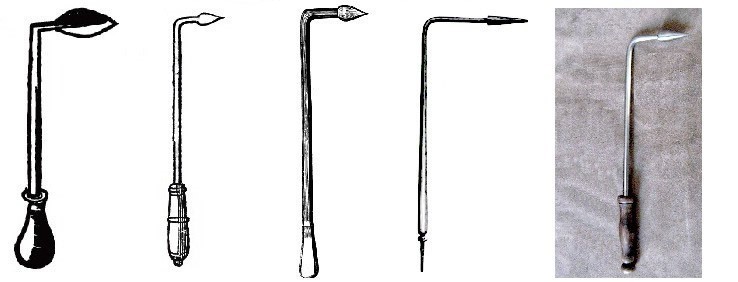 Ensel Cautery Irons - From Left: Ambroise Paré (1649), Pierre Dionis (1740), Jacques Guillemeau (1597), Johannes Scultetes (1666) And an Ensel Cautery Iron forged by Adam Cyphers of Metal Wacker's Forge for the author in 2013 |
1 Jacques Guillemeau, The French Chirurgerie, p. 23; 2 Pierre Dionis, A course of chirurgical operations: demonstrated in the royal garden at Paris. 2nd ed., p. 467; 3 Guillemeau, ibid.; 4 Dionis, ibid.; 5,6 Guillemeau, ibid.
Actual Cautery Properties - Cautery Types: Cutting
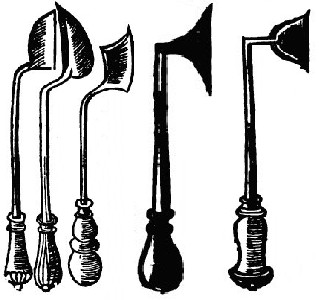
Cutting Cautery Irons, from The Workes of that Famous
Chirurgion Ambrose Parey (1649)
Cutlery Cauteries were heated and then used to make incisions, presumably with the idea that the cutting blade would also cauterize the vessels it sliced through to stop them from bleeding. Elizabeth Bennion tells us that such cauteries were quite popular in medieval Italy.1 (As has been mentioned, cauterizing was at it's peak around this time.)
Based on the number and variety of them that Paré figures in his book (as seen at right), they must have had a certain popularity in France [Paré's home country] as well.
Pierre Dionis explains that his figure shows a "Cultellary [Cutlery] Cautery, that is a sort of Knife which cuts only one side."2 Jacques Guillemeau expands upon this, noting that the cutlery cautery "hath a thicke backe, because it shoulde continue the longer hott, and effectuate his operatione so much the better."3 He goes on to say that the "backe... must be verye thicke" and that the edged side "must be foure goode fingers breadth longe."4 This is a fairly substantial iron!
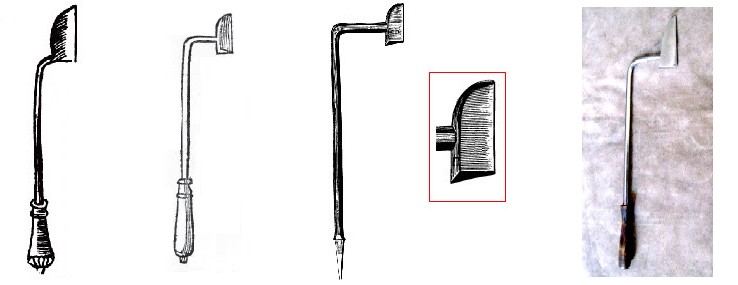 Cutlery Cautery Irons - From Left: Paré (1649), Pierre Dionis (1740), Jacques Guillemeau (1597), and an Iron forged by Adam Cyphers |
Military surgeon Richard Wiseman mentions two other types of cutting cautery not figured in any book - chisel and scoop cauteries. While Wiseman is not one to go into great detail about the appearance of his tools, he does explain how he removed a cancer in a patient's mouth using one of these. "I passed a Chisel cautery into the body of [the cancerous growth], and made a riddance of a great part of it, cutting and burning through the Alveoli, which was as rotten as dirt, till the Patient grew weary, and the Physicians thought it was enough for that time."5 Even the humblest instruments could serve as cauteries when heated!
Wiseman used the scoop cautery in conjuction with the chisel, as he explains in the details of another cancer case. Here, he explains that you must be "thrusting at the root [of the cancerous growth] with a Scoop or Chisel-like Cautery, carrying it away before you."6 Presumably the edge of the scoop would be sharpened to be able to slice into the skin.
1 Elizabeth Bennion, Antique Medical Instruments, p. 184; 2 Pierre Dionis, A course of chirurgical operations: demonstrated in the royal garden at Paris. 2nd ed., p. 467; 3,4 Jacques Guillemeau, The French Chirurgerie, p. 23; 5 Richard Wiseman, Eight Chirurgicall Treatises, 3rd Edition, p. 114; 6 Wiseman, p. 105
Actual Cautery Properties - Cautery Types: Flat
Having a large surface area by definition, flat cautery irons were typically used to treat wounds on the epidermis (upper layer of skin) or during amputation to treat the stump.

Flat Cautery Irons, from The Workes of that Famous
Chirurgion Ambrose Parey (1649)
Since there are skin wounds in a variety of shapes and sizes, there are flat cautery irons in a variety of shapes and sizes to treat them. This may explain why Ambroise Paré's book contains more varieties of flat cautery irons than any other type as seen at left.
Jacques Guillemeau gives us some detail on the use of three flat cautery irons and Pierre Dionis mentions two of the three, so these were clearly a popular style of cautery.
The first type of plate cautery Dionis discusses is "the round Plate Cautery, which is used to correct or prevent Putrefaction after a Member is cut off."1 Guillemeau concurs, explaining that this iron "hath a rotunde plate, and is vereye necessarye to be usede after an extirpatione [amputation], therwith to correcte the corruptione which is as yet remanente [remaining]."2 The idea here appears to be that after a gangrened limb is removed, some of the infection still remains at the wound site and must be burned away. Most of the golden age of piracy era surgeons recommended cutting a damaged or infected member away at least three or four inches above the infection3, so it is unlikely that burning the severed tissue at the end of a stump did much to destroy gangrened cells. It most likely stopped the bleeding, though.
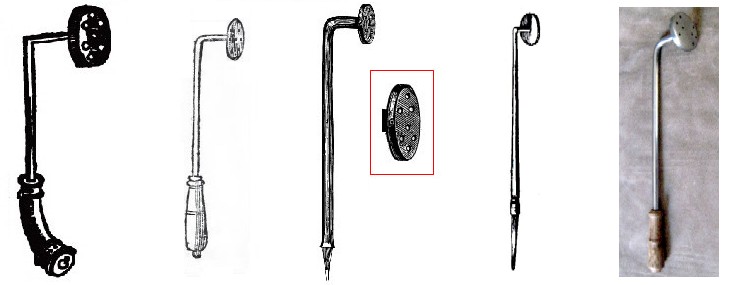 Round Plate Cautery - (l to r): Paré (1649), Pierre Dionis (1740), Jacques Guillemeau (1597), Johannes Scultetes (1666) and Adam Cyphers |
The second type of plate cautery that Dionis mentions is the eight-sided one, which he calls "the great Plate Cautery, of an Octagonal Figure, which is apply’d red hot to the Place, from which we have cut off a Cancer, in order to dry up the Corrosive Humidities, and at the same time stop the Blood of the open Vessels."4 Why an octagonal shape would be preferable to any other in treating a skin wound is a mystery. Perhaps the obtuse corners allowed the surgeon to better cauterize the ragged edges of a wound?
Guillemeau assigns a different purpose to this iron. He suggests it be used "after the extirpatione [amputation] of a member, to cauterize the bone, & the fleshe, and the whole parte alsoe, which might in anye sorte be aulterede by the corruptione, or Gangrene."5 This is basically the same reason he listed for using a circular plate cautery, making this iron appear somewhat superfluous in his collection. It may have been that he wanted corners to get inside of the uneven surface of the wound created by amputation, although since the cutting process of an amputation was usually accomplished in a single slice this seems unlikely.
In addition to explaining the use of the octagonal cautery, Guillemeau explains the purpose of the holes in the plate. "The perforations, or holes which are in the plate, because hereby the smoke might exhale, which through the cauterizatione is made."6
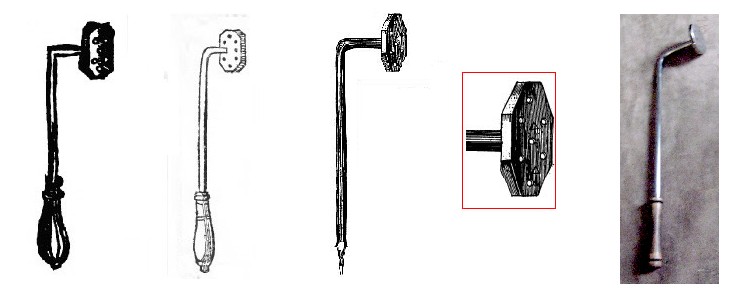 Great Plate Cautery Irons - From Left: Paré (1649), Pierre Dionis (1740), Jacques Guillemeau (1597), and an Iron forged by Adam Cyphers |
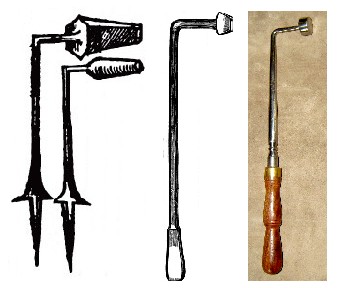
Round Flat Cauteries - {l to r): Paré (1649), Jacques
Guillemeau (1597), and G. Gedney Godwin
The last type of plate cautery that Guillemeau examines has a flat tip with sloping, rounded sides. He feels that this iron (seen in the center of the image at right) is "very commondiouse to correcte the caries [rotten parts] of the bone."7 Guillemeau emphasizes that the flat end of the cautery "muste onlye touch, the caries of the bone" which reveals why the sides in his drawing are sloped - to avoid contact with other parts of the body. This again suggests that such cautery irons would have to be designed to fit the wound site.
This type of iron is different from the previous two plate cauteries in that it's purpose is to work inside the body instead of just being limited to the suface.
Guillemeau also explains that this cautery iron can be used in the "Cauterizinge of the orifices of anye vaynes, or Arteryes, which are situatede between bones of the arme, or of the Legge."7 This would be primarily useful when performing an amputation.
1 Pierre Dionis, A course of chirurgical operations: demonstrated in the royal garden at Paris. 2nd ed., p. 467; 2,3,4 Jacques Guillemeau, The French Chirurgerie, p. 23; 2 See for example.John Woodall, the surgions mate, p. 176 & ichard Wiseman, Of Wounds, Severall Chirurgicall Treatises, p. 451; 4 Dionis, ibid; 5,6 Guillemeau, ibid.; ;
Actual Cautery Properties - Cautery Types: Round/Curved
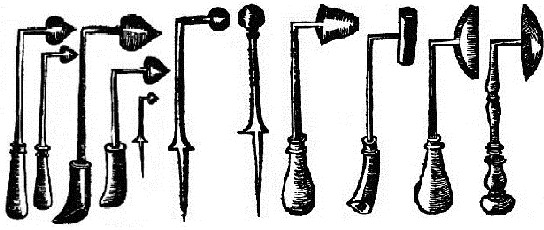
Flat Cautery Irons, from The Workes of that Famous
Chirurgion Ambrose Parey (1649)
Although Paré figures more flat cautery irons in his book than curved ones, he still provides a fairly impressive variety of round cauteries, suggesting their popularity. The human body consists of rounded surfaces, so it seems natural that rounded instruments would have a great deal of applicability
Although most period authors don't make a point of mentioning the particular types of cautery irons they use, those who do mention two round cauteries in particular: the button and olive cauteries.
Richard Wiseman, a late 17th century fan of cauterizing wounds often identifies which cautery irons he uses in his operations. One discussed several times is the button cautery. He uses it repeatedly in operations to remove cancerous skin by cauterization.1 He also recommends them in drying up the humors [fluids inside wounds thought to control healing] in the skin during hernia operations, explaining that when performing such an operation, there are "required various sorts of Buttons, some bigger and less than other."2 He also uses them to stop bleeding; upon encountering a bleeding 'capillary Artery', he "burnt it down by a small Button-cautery."3
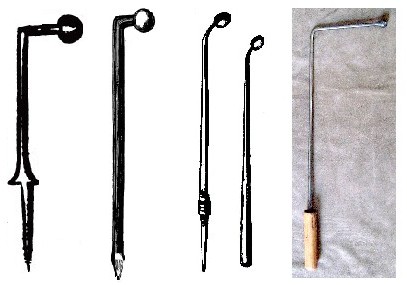
Smooth Button Cautery Irons, (l to r): Paré (1649),
Jacques
Guillemeau (1597),
Johannes Scultetes (1666) and Medieval Design
Wiseman does note that "stopping of the Bloud [in a Cancer] by a small Button cautery ...is not done without some pain, but that is momentary and serves to correct the indisposition of the Part, and rendreth it crude and ill disposed."4
The button cautery comes in two different styles. The first is a smooth button, as seen in the drawing at right which is "smoothe and even, like unto the baldnes of a mans heade."5
Guillemeau doesn't mention using it in any of the ways Wiseman does, instead suggesting it "is verye profiatable to singe the skinne in anye place there to make a fontanelle [a wound that is kept open to allow the escape of 'bad' humors.]"6 So this is probably not the type of button cautery to which Wiseman is referring.
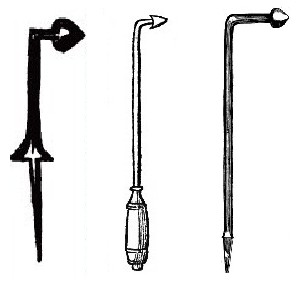
Button Cautery with Point - From Paré
(1649), Pierre
Dionis (1740), & Jacques Guillemeau (1597)
Pierre Dionis explains that the other type is called "the Button Cautery, because made like a Button, with a small point in the middle."7 The figures corresponding to this type of cautery from the period books can be seen at left. Guillemeau expands upon this noting that this type comes "with a sharpe buttone necessary to restraygne all fluxions of bloode, whether it be out of an Arterye, or out of a vayne cut a sunder, we collocatinge the same above one [on] the apertione [aperture]: It may alsoe be usede after the extirpatione [amputation] of anye Joyncte [joint]."8
It makes sense that this type of cautery iron would be better used for stopping bleeding; the point would allow the surgeon to better position the iron when being applied.
Based on Guillemeau's explanation of how this cautery was used, it is fairly certain that this is the type of button cautery to which Wiseman was referring in his book.
The second type of cautery iron that is mentioned by various authors from this period is the olive cautery, "so term’d from its being shap’d like s small Olive."9 Richard Wiseman finds the olive cautery useful in removing cancers, as he explains several times in his book.10 Guillemeau gives the olive cautery a different purpose, advising that it is used "to cauterize the Heade eve[n] unto the Sculle, or Cranium"11. There is no obvious reason to restrict it to this purpose, however. With its narrow, flat tip and sloping sides, it would seem an ideal tool to perform removal of unwanted flesh as Wiseman suggests.
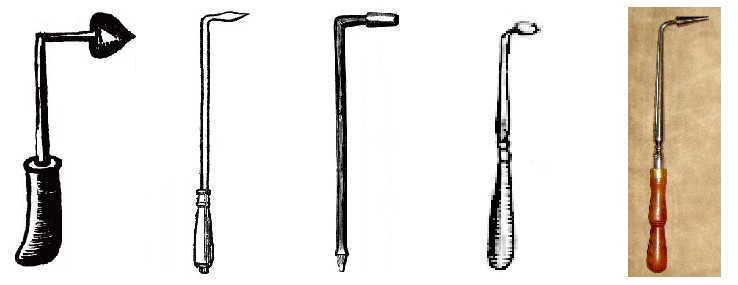 Olive Cauteries - (l to r): Paré (1649), Pierre Dionis (1740), Jacques Guillemeau (1597), Johannes Scultetes (1666) and G. Gedney Godwin |
As was seen in the first image in this section, there were several different varieties of curved cautery irons, many of which are not discussed in the period books. Some are shaped like dishes, others like curved back circles and still others like upside-down bells. Most of these have large a fairly surface area, suggesting they would be used for surface wounds.
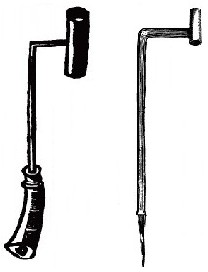
Round Cautery - From Ambroise Paré
(1649) & Jacques Guillemeau (1597)
While he doesn't discuss those, Guillemeau treats us to discussions about two other types of cautery irons. The first, seen at left,

Skull Cautery
Guillemeau
(1597)
he refers to as a "rotunde Cauterye according to the longitude thereof, which is verye necessarye, agaynste all caries of the bones."12 He probably felt it was necessary because it was long and round (like most of the bones) and would only burn where the apex of curve touched the bone. A drawback of this cautery for such a purpose would be that it required having a large swath of open skin to operate, however.
The second type of cautery that Guillemeau discusses in detail is the one seen at right. He does not name it, referring to it as being "rotunde concavouse, & rescindente"13. Comparing it to the other cauteries in his drawing, it appears to be about 1-1/2 inches in diameter with a dish-like impression inside. Guillemeau explains that it was used "to cauterize the skinne of the Heade, when as suddaynly we woulde trepane the same, as beinge in anye compagnye, and in cuttinge we feare anye greate fluxion of bloode, so the end to give, or make place to the Trepane [trepan - cut a hole in the skull]."14
1 See Richard Wiseman, Eight Chirurgicall Treatises, 3rd Edition, p. 105, 109 & 113; 2 Wiseman, p. 152; 3 Wiseman, p. 184; ,4 Wiseman, p. 113; 5,6 Jacques Guillemeau, The French Chirurgerie, p. 23; 7 Pierre Dionis, A course of chirurgical operations: demonstrated in the royal garden at Paris. 2nd ed., p. 467; ,8 Guillemeau, ibid.; 9 Dionis, ibid.; 10 See Wiseman,

